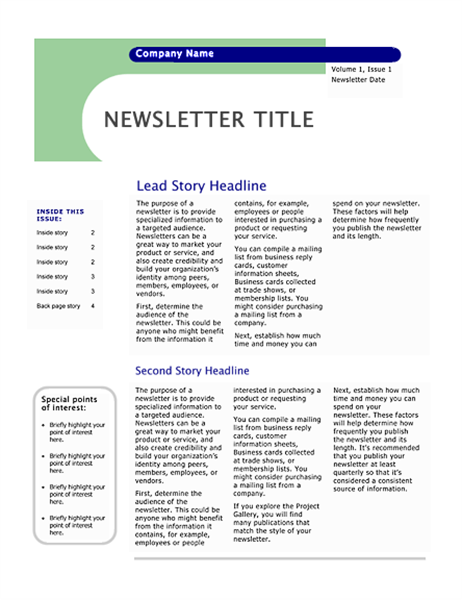
Will you be sending out a monthly email newsletter, or a quarterly print newsletter? Will it be a long, in-depth read or a quick, bite-sized update? Deciding on format and frequency will help you plan your content and keep your employees informed. Identify your target audience: Who will be reading your newsletter? Will it be distributed to all employees, or just certain departments or teams? Knowing your target audience will help you tailor your content and ensure that your newsletter is relevant and engaging.ĭecide on format and frequency: There are many different formats and frequencies to choose from when it comes to employee newsletters. Are you looking to keep employees informed about company news and updates, promote new initiatives, recognize employee achievements, or something else? Having clear goals and objectives will help you stay focused and ensure that your newsletter is effective in meeting your needs. “They didn’t have any people besides me - or any people they wanted - that had over five years, so they had to lower the requirements so they could get somebody,” Berghorst said.Determine your goals and objectives: The first step in creating a company employee newsletter is to determine what you hope to achieve with it. Then, a short time later, she said the job was reposted to require only three years of management experience, and BNSF went on to hire two men with much less experience than Berghorst for the job. The job listing said she needed five years of management experience, but Berghorst said she couldn’t get a good explanation about why she never got an interview. She said the representative she talked to never could point to any deficiencies in her resume.Īccording to Berghorst, one of the most troubling examples of being passed over for a job came when Berghorst applied for a training job after she had been known throughout her career for teaching other workers, and she already had more than eight years of managerial experience. But Thompson, whose Casey Jones law firm specializes in representing railroad workers, said he’s never seen anyone else have issues returning to that job later because they stepped down.īerghorst said human resources officials never seemed to have a good answer when she asked why she was being passed over. “I was going through quite a bit of stuff and getting ready for what would soon be my transition,” she said.īerghorst’s lawyer Nick Thompson said it’s not unusual for roadmasters to step down from those jobs that require people to be available all the time when they are dealing with personal issues, such as a divorce.

Berghorst had worked her way up in the ranks to several different management jobs, but she decided to step away from a demanding roadmaster job in 2016 when she was struggling with mental health issues. That was in sharp contrast from earlier in her career when the 50-year-old was promoted regularly before her gender transition in 2018.īerghorst said she had even previously held some of the jobs she was applying for and got positive reviews from her supervisors when she did them.
EMPLOYEE NEWSLETTERS FULL
“Once hired, our employees are entitled to be treated with dignity and respect have equal access to tools, resources, training and development opportunities and have equal opportunity to achieve their full potential,” Kent said.īerghorst still has the plaque the railroad gave her thanking her for “making a significant impact on BNSF’s diversity and inclusion journey” hanging on her wall.īut around the same time she got that award, Berghorst said she was struggling to even get an interview for the more than a dozen jobs she applied for despite her impressive resume.

Kent cited the PRIDE+ employee group that Berghorst helped form as evidence that BNSF “is committed to a diverse and inclusive workplace.” But railroad spokesperson Lena Kent defended BNSF’s hiring practices and said the railroad doesn’t discriminate against people based on gender identity and sexual orientation.

“I’m extremely disappointed that this is where it had to go,” she said.īNSF declined to comment directly on Berghorst’s lawsuit, and it hasn’t yet responded formally in court. Randi Berghorst sued the Fort Worth, Texas-based railroad in federal court recently, arguing BNSF discriminated against her.


 0 kommentar(er)
0 kommentar(er)
